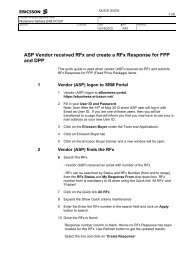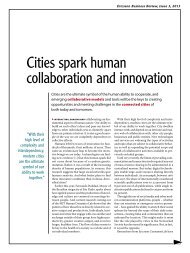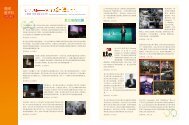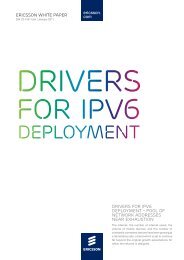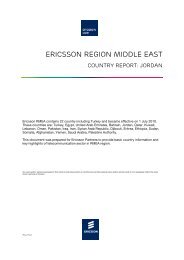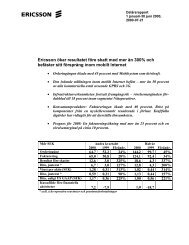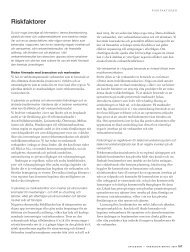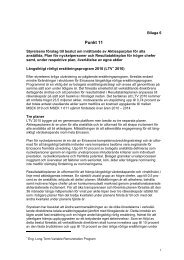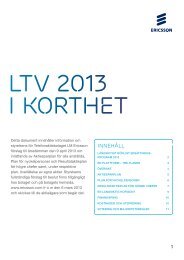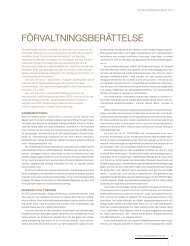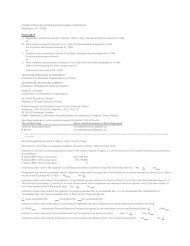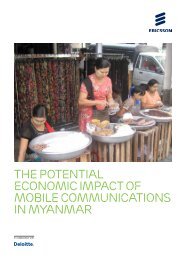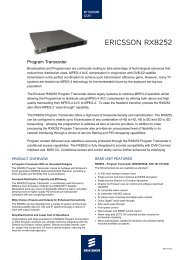Telenor's - Ericsson
Telenor's - Ericsson
Telenor's - Ericsson
- TAGS
- ericsson
- www.ericsson.com
Create successful ePaper yourself
Turn your PDF publications into a flip-book with our unique Google optimized e-Paper software.
executive summary<br />
»»»<br />
64 EBR #3 2010<br />
ond is to be a vertical solution<br />
provider, making the whole<br />
solution. The third is providing<br />
a sort of Internet of Things<br />
switch. Telenor has taken all<br />
three positions. Telcos are good<br />
at doing the same thing over<br />
and over again and doing it<br />
with high quality. But in m2m,<br />
you really have to understand<br />
the requirements and functionality<br />
to do this properly at all<br />
levels, including installations<br />
and maintenance of devices.<br />
Moving beyond m2m to the<br />
Internet of Things market, you<br />
need standard interfaces to get<br />
access to the information without<br />
having to know a lot about<br />
the connectivity and the devices<br />
themselves. You need an<br />
abstraction layer in between so<br />
getting access to device data<br />
becomes as easy as making an<br />
internet application. This will<br />
require standardization that is<br />
not in place yet.<br />
The Internet of Things in the<br />
eyes of the users<br />
By Joakim Formo, page 32<br />
The Internet of Things needs<br />
innovative ways of interfacing<br />
with its users to make it clear that<br />
its power is not in any of its single<br />
connections, but in the totality<br />
of interconnections. Otherwise<br />
it is going to be very hard to<br />
create the mass-market platform<br />
the industry is hoping for.<br />
Different kinds of gadgets and<br />
gizmos are gradually turning<br />
into hybrid devices that are<br />
services as much as they are<br />
physical objects. These days,<br />
the pads and pods – in all their<br />
different shapes and forms –<br />
are also expected to be the<br />
portals to an integrated ecosystem<br />
of services and applications.<br />
But how do we create<br />
mass demand?<br />
The technology has to be<br />
shaped into something people<br />
understand, like, want and<br />
enjoy. Designing innovative<br />
service concepts and novel<br />
ways of interacting with technology<br />
is very much about<br />
understanding how users apply<br />
mental models to make sense<br />
of something.<br />
In one study, most of the participants<br />
confirmed that they<br />
knew what a wireless network<br />
was, in reality meaning that<br />
they knew what it was used for,<br />
or how to use it.<br />
However, none of the participants<br />
actually explained their<br />
Wi-Fi networks by describing<br />
any of the characteristics of a<br />
network. The participants’<br />
definition of a wireless network<br />
was that it is something (typically<br />
a laptop) that connects to<br />
the internet, for example. In<br />
other words, people casually<br />
define a wireless network as a<br />
replacement for a cable.<br />
For the Wi-Fi networks in our<br />
homes today, the metaphor of<br />
invisible wires is perfectly adequate.<br />
But for a future scenario<br />
where we have billions of<br />
networked things, this simplified<br />
understanding becomes a<br />
limitation.<br />
Its true power is to be found in<br />
the core characteristics of the<br />
network as such, and the opportunities<br />
that these core<br />
characteristics enable are currently<br />
hidden in a blind spot<br />
created by the mental model<br />
and the analog ancestors. Users<br />
may think they understand<br />
what the Internet of Things is,<br />
but in fact, they will not be able<br />
to see its real potential.<br />
The cable is currently the mental<br />
model for a network and the<br />
World Wide Web is about to<br />
become the analog ancestor of<br />
the Internet of Things. These<br />
metaphors are insufficient to<br />
explain the nature and opportunities<br />
of this technology evolution.<br />
A new innovative and<br />
intuitive way of understanding<br />
the interconnections must be<br />
introduced. Otherwise an insufficient<br />
mental model will<br />
obscure the possibility of having<br />
50 billion connected devices.<br />
Chinese technology’s big<br />
chance to go global<br />
By David Callahan, page 36<br />
▶ The Chinese government<br />
sees the Internet of Things as<br />
an opportunity to take the lead<br />
in global technology standardization,<br />
according to Flora<br />
Wu, principal analyst with bda,<br />
a Beijing-based consulting<br />
firm.<br />
There are several technologies<br />
competing and no set standard<br />
yet. That is one reason for the<br />
Chinese government’s ambitions.<br />
China has rolled out its<br />
own 3G technology and now<br />
the government and operators<br />
are starting to invest in lte, 4g<br />
and the post-4g technologies.<br />
In addition to a sensor technology<br />
center in Wuxi, the Ministry<br />
of Industry and Information<br />
recently collaborated with the<br />
local Wuxi government and<br />
Jiangsu Province to create a<br />
national r&d center devoted to<br />
the Internet of Things.<br />
China Mobile, China Telecom<br />
and China Unicom have taken<br />
the lead in the Internet of<br />
Things market. China’s largest<br />
operator, China Mobile, already<br />
counts 5 million m2m terminals<br />
in its network – about 60 percent<br />
more than 2009.<br />
Che Wu Tong, a car telematics<br />
and location-based application<br />
for vehicles, is China Mobile’s<br />
most widely used m2m service.<br />
Chongqing Mobile is the base<br />
for parent company China Mobile’s<br />
m2m business and its<br />
capabilities will be upgraded to<br />
operate the platform for the<br />
entire network. To date, five<br />
provincial subsidiaries have set<br />
up their own m2m platforms,<br />
Wu says.<br />
China Mobile has piloted livestock<br />
tracking, as well as remote<br />
greenhouse monitoring.<br />
By October 2009, as many as<br />
80,000 terminals were involved<br />
in these trials.<br />
China Telecom has trialed<br />
M2M applications in dozens of<br />
industries, including transportation,<br />
energy and environmental<br />
sustainability. In the financial<br />
sector, China Unicom has<br />
launched a service enabling<br />
customers to use handsets to<br />
make payments from their Bank<br />
of Communications account.<br />
Yu Xiaohui, deputy chief engineer<br />
of China Academy of<br />
Tele communication Research<br />
(catr) says the Chinese government<br />
is exploring how the<br />
Internet of Things can raise<br />
living standards and improve<br />
industrial productivity in a<br />
“smart and green” way.<br />
The Internet of Things will also<br />
play an important role in raising<br />
the living standards of the<br />
Chinese people, for example by<br />
improving food safety and security.<br />
The application of the Internet<br />
of Things is still in the explorative<br />
stage, and Yu thinks there<br />
is still a need for an action plan<br />
and a strategic road map.<br />
He says the Internet of Things<br />
consists of three very important<br />
key factors: one is sensing<br />
and identification; the second<br />
is transmitting information via<br />
the interconnected networks;<br />
and the third is intelligent processing<br />
of information.<br />
m2m is a core part of the Internet<br />
of Things, but it doesn’t<br />
represent the whole concept.<br />
As well as the communication<br />
between machines, there<br />
should be a human aspect to<br />
the concept. Via the Internet of<br />
Things, people should be able<br />
to identify and control the nature<br />
of the machines to improve<br />
productivity and living<br />
standards.<br />
Operators need an ecosystem<br />
to support 50 billion<br />
connections<br />
By Mats Alendal, page 40<br />
▶ Network operators are very<br />
well positioned to benefit from<br />
the m2m wave, given their ability<br />
to stimulate ecosystem developments,<br />
influence consumer<br />
behavior and, potentially,<br />
provide services to customers.<br />
However, operators need to<br />
shift their business away from<br />
supplying voice and data services<br />
toward becoming an integral<br />
part of a wide variety of<br />
industrial vertical solutions.<br />
Real-time capabilities and<br />
quality-of-service (QoS) guarantees<br />
will be critical. Operators<br />
should also ensure their<br />
m2m platforms are open and<br />
standards-based to provide<br />
interoperability between ecosystem<br />
players and vertical industries.<br />
But this is not the only



